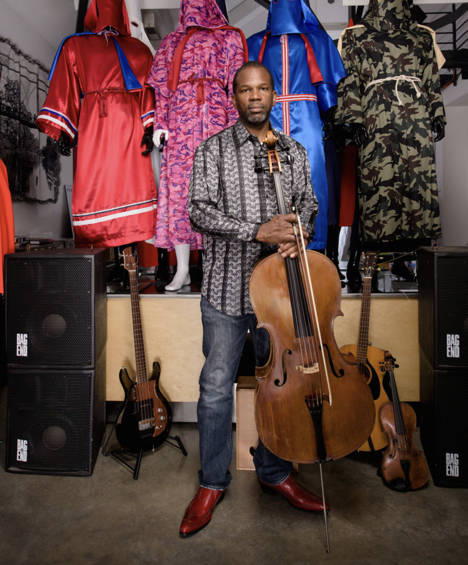by Jay Kimball
Special to the Sounder
Tickets to the Sept. 28 Woman in the Woods Productions event sold out in record time.
The packed Orcas Center theater audience, elbow to elbow, was often so quiet you could hear the proverbial pin drop. Paul Rucker – visual artist, composer, musician, and Guggenheim and TED Fellow — began his art education as a janitor at the Seattle Art Museum.
On Orcas, Paul was a navigator through a place most of us can never go. With hand firmly on the tiller, he guided us through 400 sobering years of what should have never been — the creation of American slavery, racism and the endless PTSD that grips our nation still.
On his sonorous cello, he bows bass notes so deep, we feel them in our bones. Those primal vibrations prepare us for what is to come. With gentle voice that belies the stark reality of the images that softly evolve on the wide-screen above, Paul narrates the insanity that unfolds before us. Chattel slavery documents morph into trees with strange fruit – black men lynched, hanging, swinging slowly. The cello weeps.
It is shocking. It is unacceptable. And we cannot stop looking.
Objects of slavery flash by on the screen. Iron brands with the letter “R” to burn into the flesh of captured runaway slaves. Racist collectibles — hundreds of postcard images of KKK rallies and lynchings, to send to friends.
We see hand-sewn Klan regalia Paul made “as a way to wrestle with its sinister power, and with the memory of seeing KKK rallies in South Carolina” where he grew up. A camouflage Klan robe symbolized how racism has the power to hide, to blend in.
Paul has said, “The lynchings have not stopped, they’ve merely changed forms — from rope to guns. I created a new piece called ‘You Might be Disturbed by Images Beyond This Point.’ I’ll place it at the exit of every gallery I show at because I can’t make anything more disturbing than reality.”
What Paul is doing may be seen as an act of love. In interviews, Paul has likened racism and the legacy of slavery as a festering collective wound. Rather than cover it up, hiding the infection and rot, we need to cut open the wound and clean it, to heal.
He says, “Progress is being made through the pain of reality, through knowing and understanding that we have not gotten as far as we think we have. We can make progress, but we have to engage with people outside of our own communities.”
He has come to our community with hope. Spending time with school kids and adults, Paul practices his art — a modern-day Griot, sharing the stories that can make us whole, together. Tending to the wounded. Looking back, to move forward.
To learn more, Google the following terms: NEA-Rucker, 1619, the-middle-passage, Emmett-Till, strange-fruit-FBI, Tuskegee-Experiment, Seattle-KKK, Delbert-Richardson-traveling-museum, NMAAHC, ten-ways-fight-hate, boogz-color-of-reality.



